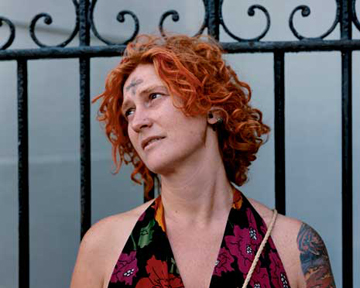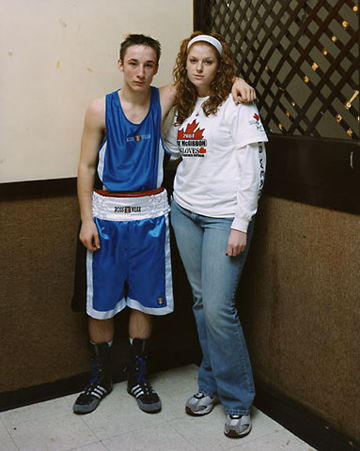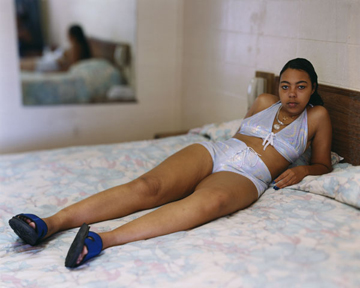The practice of photographic portraiture is rife with ethical implications – from the subject’s awareness of the project, to the artistic choices made throughout the session, to the work’s resulting place within the art market. The process behind the portraiture is particularly interesting to me, especially in how the relationship between the artist and subject can impact the ethical considerations of the project. The artist Alec Soth‘s frank style of portraiture is realized through his ability to make his subjects feel comfortable in front of his camera. In an article last year in the New York Times, Julian Cox, Curator of Photography at the High Museum, was quoted, saying that Soth “communes with his subjects and his environment through the ritual of the photographic act. He’s a very natural type of communicator. That’s part of his magic formula for having his subjects turn themselves over to him.” Soth was kind enough to allow me to interview him about the relationships he builds with the subjects of his portraiture, and how it affects his resulting work.
Rachel Craft: I’d be curious to learn more about your process leading up to the photography session. When you find a subject, what are your first steps?
Alec Soth: My approach really varies from project to project. When working with a large format camera, I’ll often approach people while leaving the camera in my car. I’ll just talk to them, explain what I’m doing and ask if they’ll pose. In terms of the explanation, I try to be as honest as I can about what I’m doing. But sometimes this is made difficult by the fact that I really don’t know what I’m doing. Lately I’ve been working in a really free-form intuitive way and I’ve been having a hell of a time communicating this to the people I photograph.
RC: Does your relationship with your subject, and how easily he or she accepts the idea of your project, influence the resulting work?
AS: I wish there was a formula for great pictures, but there absolutely isn’t. Personally I don’t like to be too close to the people I photograph. If I could, sometimes I think I would take their picture without us ever talking. I like to imagine their personality based on their physical attributes. For this reason, it is really rare that I photograph family and friends.
RC: Your portraits always feel like a very honest portrayal of the person. To what extent do you allow your subject to choose how they represent themselves and to what extent do you project your own perspective on their portraits?
AS: It’s really hard to say. I mean, I don’t go out with a bag of a costumes and ask people to perform in my play, but I’m not comfortable saying that I’m entirely neutral. I choose the people, I choose the moment to snap the shutter and I choose the final picture. All of these little decisions add up to a lot of power in terms of how the person is represented.
RC: After the subjects confirm that they will participate, what kind of agreements do you make with them? Has there ever been a disagreement or objection to a photograph after it’s complete and how do you handle those kind of situations?
AS: With the slower, large format portraits, the subjects sign releases and I send them a picture. This release is very short and doesn’t really cover much. For me, it is just a way to confirm that they are okay with me using the picture. But lately I’ve been doing a much faster kind of photography that doesn’t allow for releases. We’ll see what happens. I’ve only had one situation that has blown up in my face. This was a rather exceptional situation and I prefer not to go into the details. But in the end, everything got worked out and I’m free to continue exhibiting the picture.
RC: I know that you interview many of your subjects. Do ethical considerations influence your decision to conduct these interviews? And how do their stories factor into your work?
AS: My work is all about wandering around in hopes of connecting experiential dots into a larger picture. These little informal interviews are all about finding ways for me to make connections. The interviews are rarely visible in the final project, but they help form the scaffolding for the project.

Alec Soth, "Adelyn, Ash Wednesday, New Orleans, Louisiana," from the series "Sleeping by the Mississippi," 2000.
RC: In the text that accompanies your photograph of Sunshine in the Sleeping by the Mississippi series, you returned to Memphis to give her a copy of your work. Is this a typical part of the process?
AS: It is rare, but it sometimes happens. Oddly enough, it just happened. I photographed a woman named Adelyn on Ash Wednesday in New Orleans ten years ago. She recently contacted me by email and we had a nice little chat. She’s currently living in Austin but told me she was going back to New Orleans for Mardi Gras. So I flew down and photographed her again. It was a thrill. The funny thing was that the encounter was only about fifteen minutes long. We didn’t talk that much. I don’t really want a transcript of those ten years of her experience. I want to look at the picture and imagine those ten years.
RC: Do you discuss the resulting location of the artwork (art market, museum, gallery) with your subjects?
AS: Well, in the case of Adelyn, when I photographed her ten years ago, I was a complete nobody. I never imagined that this picture would be on a museum wall. Nowadays I do sometimes explain this, but in a limited way. The odds that the picture is good and will be seen is still awfully slim.






Pingback: What’s Cookin at the Art21 Blog: A Weekly Index | Art21 Blog
Pingback: The Digest. 03.08.10. « C-MONSTER.net
Pingback: Flash Points Wrap-Up: Art For Life | Art21 Blog
Pingback: MoCP Collection Artist Update | Leonardo Turrin Photography
Pingback: The Art21 Blog’s Most-Viewed Posts of 2010 | Art21 Blog
Pingback: MoCP Collection Artist Update
Pingback: Lens Profile – Alec Soth | chancelillehei
Pingback: Hidden America – Alec Soth and Finding the Unexpected Exotic – Lens Blog